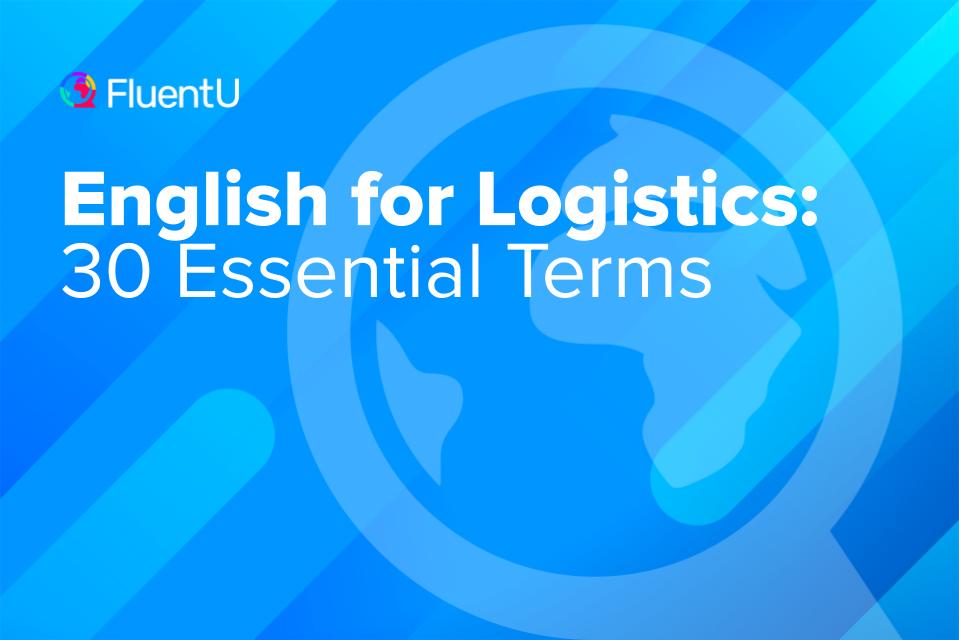Contents
- Essential English for Logistics Vocabulary
- Advanced Shipment Notice (ASN)
- Air Taxi
- Backorder
- Bilateral Contract
- Blanket Purchase Order
- Business-to-Business (B2B)
- Business-to-Consumer (B2C)
- Consignor and Consignee
- Customs Officer
- Distribution Network
- Freight
- Inbound Logistics and Outbound Logistics
- Inventory
- Lading
- Logistics Service Provider (LSP)
- North American Free Trade Agreement (NAFTA)
- Order Picking
- Order Processing
- Original Equipment Manufacturer (OEM)
- Owner’s Risk
- Packaging
- Pareto Principle
- Pooling
- Preferential Rate
- Request for Information (RFI)
- Route Optimization
- Supply Chain
- Transportation
- Unit Loads
- Warehousing
- Resources to Improve Your Logistics Vocabulary
- And One More Thing…
English for Logistics: 30 Essential Terms

Effective communication is vital in the world of logistics, where accuracy and clarity are key.
In this post, we’ll explore 30 important terms used in logistics. From packaging and inventory to order processing and transportation, we’ll cover words that will help you communicate better and succeed in your logistics career.
Whether you work in supply chain management, transportation, warehousing or customs clearance, having a solid grasp of logistics terminology is essential for seamless operations.
Download: This blog post is available as a convenient and portable PDF that you can take anywhere. Click here to get a copy. (Download)
Essential English for Logistics Vocabulary
Below is a list of commonly used terms and abbreviations used in logistics.
Advanced Shipment Notice (ASN)
This is a document that tells your customer all the information they need to know about a pending delivery—including the type, nature and number of goods, packaging information and other relevant shipment details. It’s sent in advance to the customer so that they have an idea of what to expect and when.
Air Taxi
This is a small commercial aircraft that usually flies short distances on demand. There are restrictions on the amount of cargo and passengers allowed in the aircraft. It’s like hailing a cab when you’re in a hurry, except the cab is a plane.
Backorder
To put it simply, a backorder is when a retailer orders something that’s currently out of stock. The client trusts the company long enough to wait for the order to be shipped at a later date.
Bilateral Contract
This is a reciprocal arrangement between two parties, where you promise to do something in exchange for something in return. Both of you are bound to keep your ends of the bargain (deal or agreement).
Blanket Purchase Order
Also referred to as a blanket order or a standing order, this is a type of purchase order where a client receives regular, ongoing deliveries for large quantities of goods, thereby taking advantage of discount pricing.
Business-to-Business (B2B)
This is an approach where a business targets other businesses to access and sell their products and services. In short, the commercial transaction occurs not with the customer but with another business.
Business-to-Consumer (B2C)
This is the opposite of B2B and the one we’re more familiar with, where the transaction takes place between the business and a customer. The strategies used here differ significantly from those used in B2B marketing.
Consignor and Consignee
The consignor is the person (or firm) that sells or ships the goods to the recipient, or “consignee.” The consignor is usually the “seller” and retains ownership of the goods until the consignee pays for them.
Customs Officer
The customs officer is the law enforcement official who acts on behalf of the government and ensures that people and goods enter or exit a country legally.
Distribution Network
This term refers to the interconnected group of storage facilities and transportation systems that ensure goods are smoothly delivered from the manufacturer to the customer. The distribution network is part of the supply chain (see definition below).
Freight
This refers to the goods that are carried in bulk by land, sea or air. It can also mean the fees paid for the transportation of these goods.
Inbound Logistics and Outbound Logistics
Inbound logistics refers to the activities involved in receiving, storing and distributing goods and materials coming into a company’s premises. Outbound logistics, on the other hand, involves the processes of storing, handling and transporting goods and materials from a company to its customers.
Inventory
This refers to all the goods, raw materials or finished products that a business holds for the purpose of production, sale or distribution.
Lading
This term typically refers to the loading of cargo or goods onto a transportation vehicle. However, it also sometimes refers to the cargo itself.
Logistics Service Provider (LSP)
As the term suggests, LSPs are third parties that provide companies and clients with logistics services.
North American Free Trade Agreement (NAFTA)
This is a free trade agreement between Canada, the U.S. and Mexico and covers several issues such as those relating to customs, intellectual property rights, government procedures and so on. NAFTA was implemented on January 1, 1994.
Note that as of July 1, 2020, NAFTA was replaced by the U.S.-Mexico-Canada Agreement (USMCA). You can find more information about this on the International Trade Administration web page.
Order Picking
Order picking is the process of assembling the goods before they’re shipped off to the customer. It’s one of the basic warehousing processes.
Order Processing
This refers to all the different activities related to the filling of a customer’s orders until they’re completed. It usually includes the picking, sorting, packing and delivery of goods to the shipping carrier.
Swift order processing is the hallmark of any wholesale retail company.
Original Equipment Manufacturer (OEM)
An OEM is usually a company that manufactures goods that are then used as components in another company’s goods. However, the term has evolved over the years and now sometimes refers to the second company (i.e. the one receiving and using the goods).
I decided to purchase the car part from the OEM to ensure compatibility and quality.
Owner’s Risk
When something is transported at the owner’s risk, it means that the owner is responsible for insuring it against any potential loss or damage that may occur during the transportation process. The owner bears the financial burden and should take necessary precautions to protect the item during transit by obtaining appropriate insurance coverage.
Packaging
Packaging involves all the processes and materials that are used to contain, transport and protect a product until it’s delivered. It also can refer to the design and production of packages.
Pareto Principle
Also called the 80/20 rule, this principle says that 80% of profits come from 20% of your work or effort. In order to improve productivity, you identify the “20%” areas and capitalize on those.
Pooling
This is a common term in shipping lingo, where multiple shipments from different carriers are combined in one truckload to reduce shipping charges.
Preferential Rate
This is a term related to customs payments. It’s a special, reduced rate for products from certain “preferred” countries.
Luckily for you, you can pay per your country’s preferential rate for exporting these items.
Request for Information (RFI)
An RFI is a document to collect written information about a vendor, product, supplier or service.
Jackie filed several RFIs when choosing the most reliable supplier for his goods.
Route Optimization
The process of determining the most efficient route or sequence for transportation to minimize time, cost or distance.
Supply Chain
The entire interconnected network of organizations, people, activities and resources that are responsible for the movement of the product from the supplier to the customer.
Transportation
This is a key aspect of any logistics operation and refers to the movement of goods via land/sea/air, as well as the procedures involved to make it go smoothly and efficiently.
Unit Loads
The combining of individual items in shipping containers into single units.
I need to find out the exact number of unit loads that will fit into this warehouse.
Warehousing
The act of storing goods that are to be distributed and sold at a later date. The commercial building where goods are stored is called a warehouse.
Tanya scaled down her plans for the start-up because the warehousing costs were too expensive.
Resources to Improve Your Logistics Vocabulary
To supplement your learning, you can check out these resources:
- Glossary of Supply Chain and Logistics Terms: This extensive glossary from Inbound Logistics includes over 1,400 definitions. Review them little by little to continue expanding your logistics and administrative vocabulary.
- Investopedia: Whenever you come across an unfamiliar turn of phrase in logistics, head over to this site to learn more about it. For instance, this page gives you a short background on logistics with examples and detailed explanations of what a logistician actually does. If you have any queries, chances are that this site will answer most of them.
- FluentU: This program helps you learn new terms by showing you authentic English videos made for native speakers. That includes business-oriented videos, like information about careers, tips for business owners, news segments about different sectors of business (including logistics) and more.
Every video comes with interactive subtitles so you can check a word’s definition without leaving the video player. You can also create personalized flashcards for any unknown words you find while watching, and practice speaking these words with quizzes that integrate typing practice and voice recognition. - Effective Business English for Logistics on Udemy: For serious learners, I recommend investing in an English course tailored to logistics professionals. This online course focuses on effective communication, staff management and efficient logistics processes. If you enjoy this resource, you can find many more engaging and effective courses on Udemy covering a range of both business and English language topics.
Take your time with this list—you don’t have to learn it all at once. Bookmark this post, review the definitions regularly and research any topics or concepts that are unfamiliar to you.
Then look for opportunities to use these terms in your daily life to get more comfortable saying and writing them. For more industry-specific terminology, see our post on construction vocabulary in English.
With some dedication and practice, you’re sure to succeed!
Download: This blog post is available as a convenient and portable PDF that you can take anywhere. Click here to get a copy. (Download)
And One More Thing…
If you’re like me and prefer learning English on your own time, from the comfort of your smart device, I’ve got something you’ll love.
With FluentU’s Chrome Extension, you can turn any YouTube or Netflix video with subtitles into an interactive language lesson. That means you can learn from real-world content, just as native English speakers actually speak.
You can even import your favorite YouTube videos into your FluentU account. If you’re not sure where to start, check out our curated library of videos that are handpicked for beginners and intermediate learners, as you can see here:
FluentU brings native English videos within reach. With interactive captions, you can hover over any word to see an image, definition, and pronunciation.
Just click on the word to see other example sentences and videos where the word is used in different contexts. Plus, you can add it to your flashcards! For example, if I tap on the word "viral," this is what pops up:
Want to make sure you really remember what you've learned? We’ve got you covered. Practice and reinforce the vocab from each video with learn mode. Swipe to see more examples of the word you’re learning, and play mini-games with our dynamic flashcards.
The best part? FluentU tracks everything you’re learning and uses that to create a personalized experience just for you. You’ll get extra practice with tricky words and even be reminded when it’s time to review—so nothing slips through the cracks.
Start using the FluentU website on your computer or tablet or, better yet, download our from the App Store or Google Play.
Click here to take advantage of our current sale! (Expires at the end of this month.)












